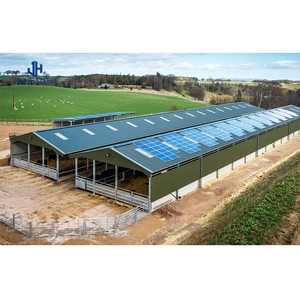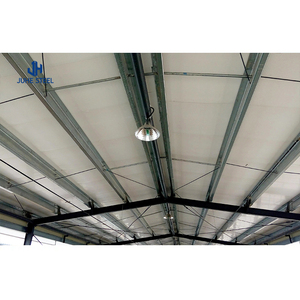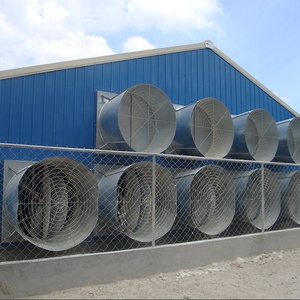
All categories
Featured selections
Trade Assurance
Buyer Central
Help Center
Get the app
Become a supplier

(1646 products available)




















































Chicken seds are available in many different types; understanding these types will help buyers find the best suitable option for their business. Here are the most common ones:
These are the most used sheds on the market. For a broiler chicken shed, the main priority is support, good temperature control, and ventilation. These chickens grow very large, so sheds must be strong and have enough room for chickens to move around safely. Most importantly, these types of chicken sheds for sale should be built with protection from harsh weather conditions and wild animals.
Layer chicken sheds are used in keeping chickens that lay eggs. Unlike broiler chickens, layer birds do not require much space but need good perches and nests. Commercial egg-producing farms use aviary or colony systems, requiring more complex and larger sheds. Buyers should look for layer houses with easy-access collecting equipment and spacious rooms for the hens.
Breeder chicken sheds house chickens intended for meat production while still in the egg stage. A good breeder shed must have many rooms for breeders, adequate ventilation, and temperature controls. It should also have separate incubation and hatching areas.
Like broilers, turkeys require strong and stable sheds that support their size and weight. Turkey sheds must be carefully designed because of the rapid growth of the birds. People should consider sheds with proper heating systems to keep the birds warm and prevent diseases caused by cold weather.
These are different from conventional chicken sheds. Free-range chicken sheds must have systems that allow easy access to outdoor ranges. Buyers should look for free-range chicken houses with large openings, pop holes, and ramps leading to outdoor areas. The outdoor space must also have adequate shade and fencing to protect against predators.
Aviary systems allow chickens to move about freely. These systems are large and complicated compared to traditional houses. They include many perches, nests, and egg-farming space. Most of them also have automated food and water supply systems, along with many collecting systems that can be automated. Buyers should look for homes constructed with high-quality, wear-resistant materials, as there will be many hardware components in these systems.
With the steady rise in demand for poultry meat and eggs all over the world, the poultry house's commercial value continues to increase by a large margin. In today's world, people are opting for chicken houses for sale to boost the productivity of their poultry businesses. Below are their benefits and commercial uses:
The primary purpose of chicken sheds is to house chickens, broilers, and layers. These buildings provide personal space for birds to grow healthily. A well-constructed chicken shed has all the features that promote the health, growth, and reproduction of the birds, making the best use of the available space.
Another important function of chicken sheds is to provide the birds with the required protection from extreme weather conditions. Excess heat or cold can severely affect the health of the birds. A good shed will have heating or cooling systems to maintain the right temperature even in harsh weather conditions.
Apart from extreme weather conditions, chickens are very vulnerable to predators such as foxes, raccoons, and hawks. Chicken sheds are fenced and designed to protect birds. Wild animals get no chance of harming chickens, thus ensuring maximum production safety.
Good ventilation is yet another very important requirement for keeping poultry birds. Poor air quality can cause respiratory problems in birds. Chicken sheds ensure a free flow of air, thus preventing the accumulation of ammonia and keeping the shed fresh. Proper ventilation also supports the healthy growth of birds, improving the rate at which they grow.
People use chicken sheds to house different types of chicken, such as meat birds (broilers) and egg-laying birds (layers). Each chicken needs a different type of shed. Production is maximized when the correct chicken sheds are used for each type of chicken grown in the poultry business.
Some operators install egg-collecting systems in layer chicken sheds. These systems reduce labor costs by automatically collecting and storing eggs. Modern equipment has a smooth flow for moving eggs to packing areas, reducing damage and improving operational efficiency.
The surge in interest in organic and free-range poultry products has increased the need for suitable chicken sheds. Free-range and organic poultry farming is in demand, requiring buyers to construct chicken sheds that meet the requirements of these types of production.
Many modern chicken sheds include advanced tools that improve farming methods. Automation, sensors, and green systems increase production efficiency and attract customers. Technology can lower costs and increase productivity, giving buyers an edge in the competitive poultry market.
In summary, the chicken shed's commercial value is supported by factors like increasing demand, modern technology, and the shed's practical benefits.
Several features must be considered when choosing the ideal chicken shed for sale. These features ensure that the shed meets the poultry farming requirements for maximum production and efficiency. Here are some of the important features:
Insulation is important for maintaining optimum temperatures inside the chicken shed throughout the year. It helps keep the shed cool during hot seasons and warm when it gets cold. Insulated walls, roofs, and doors will reduce the cost of heating and cooling the building. Working with a shed designed for the local climate is advisable, but extra insulation is required if the shed is far from the local climate.
Natural light reduces electricity costs and gives chickens the light they need for good health and production. A well-lit chicken shed improves the productivity of the layers by boosting the formation of eggs. Growing chicken meat for slaughter will also increase their desire for food, which in turn increases their growth. Roof lights and windows are good options for improving light inside the shed.
The shed flooring type depends on the kind of chicken farming method used. Concrete floors are more appropriate for intensive farming practices because they are easy to clean and very durable. Wooden or plastic floors may be used in extensive farming methods and are easy to clean and replace if damaged.
Like any other living creature, chickens need fresh air to survive. Adequate ventilation removes stale air and keeps the level of gases like ammonia from accumulating within the shed. It also supports the proper heating or cooling of the shed. Installing fans is very helpful in achieving the proper airflow.
Roosting space is a must-have for all layer and breeding chicken sheds. The space also needs to be big enough and include multiple levels so the chickens can lie on the flat roof. Ensure that the roost area is distinct from the food and water areas to avoid contamination.
Modern chicken sheds have automated food and water supply systems that ensure birds always have access to food and water. These systems reduce the time and effort that farmers have to spend caring for the birds. When choosing a shed, ensure it has the proper attachments for installing automated food and watering systems.
Maintaining disease control in a poultry farm requires high biosecurity. The chicken shed should also be designed to prevent diseases. Add features like clean and dirty area separation, footbaths at entry points, and good ventilation for effective biosecurity. These features reduce pathogen transmission and encourage good flock health.
When choosing chicken runs for sale, buyers should consider several factors to ensure adequate survival and maximum production of the birds. Below are the considerations:
The technical details of the shed, such as size, shape, and founder system, significantly impact its performance. Buyers should select sheds that meet the production needs of their poultry farm. A larger shed will be required for bigger farming businesses, while smaller farms can comfortably manage smaller sheds. The shed should have enough space for the birds to move about freely.
The type of material used to construct the chicken shed also considerably impacts how well it performs. Buyers should choose homes made from strong and weather-resistant materials like metal or treated wood. Steel is most suitable for practical and modern options, while treated timber is ideal for a natural but very strong look. Each material has its own benefits and costs.
While brand can affect price and warranty availability, it is not a huge factor for buyers. What really matters is whether the brand offers features that are required for a certain farm. Some brands may be better known for sturdier products. Buyers should consider this when choosing sheds.
Like any other house, the size of the chicken shed is crucial. The size needed depends on the type and number of birds to be farmed. Ensure there is adequate space for each bird to move around, eat, drink, and rest comfortably. Avoid overcrowding, as this will affect the health of the birds and reduce their production capacity.
Budget is always going to be a major factor. Include the cost of maintenance, operational expenses, and energy consumption in the total budget. Buying a low-priced chicken shed will cause high maintenance and operational costs over time. Always account for future expenses when estimating the budget for the shed.
Similarly, the class of the chicken shed must be compatible with the local climate. In warmer areas, for instance, opt for a shed with more cooling features. The house should be well insulated, and ery strong cooling systems are necessary to ensure that the internal temperature does not rise to dangerous levels. Look for homes with adequate ventilation and shading in hot places.
Buyers should look at the energy costs when buying a chicken shed. Some sheds have large energy bills, but others utilize natural ventilation and daylight, reducing energy bills. Additional features like fans and heaters will also raise the operating cost. Select a shed with low ongoing expenses to make the chicken business more profitable in the long run.
A1: A normal chicken shed has the following basic parts: the main body, roof, floor, doors, windows, ventilation system, and feeding and watering systems. Some are more complicated than others, requiring many other parts to complete them.
A2: Situations such as wild animals attacking the flock or thieves stealing them have devastating effects on poultry farming. Therefore, many chicken producers employ various strategies to boost biosecurity on their farms.
A3: Usually, well-constructed and well-maintained chicken sheds have a lifespan of 15 to 20 years. However, yearly check up and maintenance will increase their lifespan even further.
A4: The size of the chicken shed should be determined by the number of birds to be farmed. The shed should offer enough space for the birds to eat, drink, sleep, and move about comfortably. A larger shed will be needed for bigger chicken flocks.
A5: Yes, some chicken sheds are made of wheels so that they can easily be moved from one location to another. These are known as portable chicken coops.